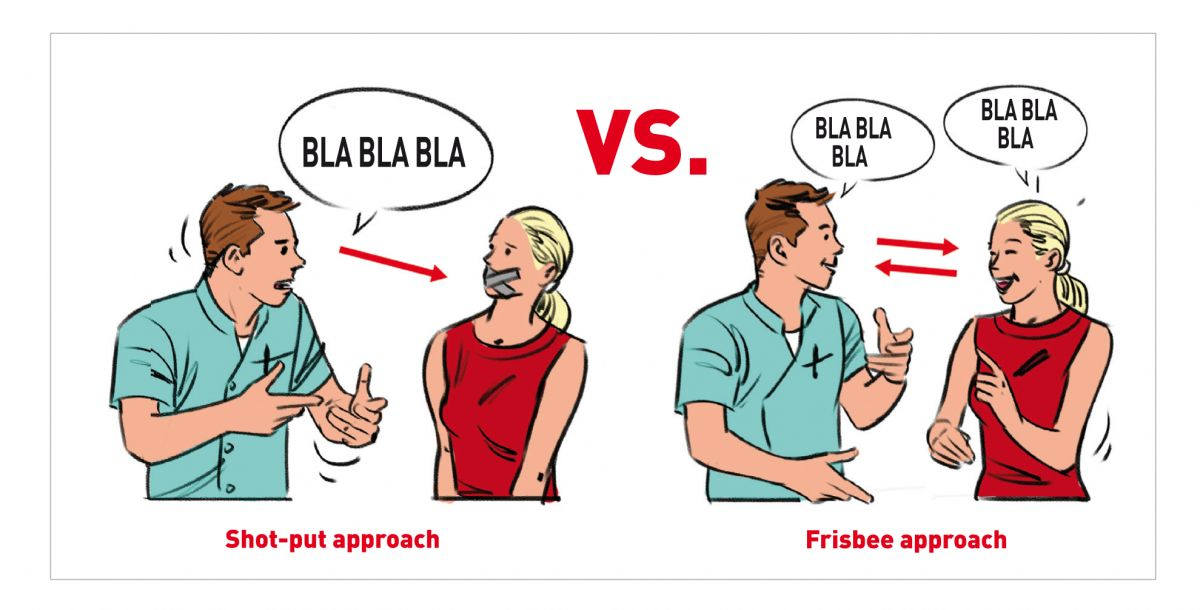Communication is a clinical skill (part 5)
Written by Miguel Ángel Díaz, Iván López Vásquez, Cindy Adams and Antje Blättner
Inclusion of the communication skills in every day practice requires us to move beyond what we do anyway to a higher level of intention in the way that we interact with clients and one another. These more effective consultations and interactions also lead to improved outcomes of care including: improved client, vet practitioner, staff member satisfaction, increased understanding and recall by clients, increased adherence and practice success. Let’s turn our attention to two useful techniques for communicating during consultations: the “shot-put” approach and the “Frisbee” approach.

Key Points
“Shot-put” and “Frisbee” approach – are essential techniques for the development of a collaborative veterinarian-client partnership.
Shot-put or Frisbee approach
All of our attempts to improve communication can be reduced to two basic perspectives: the Shot-put approach and the Frisbee approach (Figure 1). The shot-put defines communication simply as the well-conceived, well-delivered message or more affectionately referred to as the “Park and Bark”. Many of us have attended lectures over the years, some of which are not of the highest quality and some of the following have contributed to them being less desirable:
- The lecturer speaks solid for 50 minutes and is unwilling to take questions until the end
- The lecturer used jargon you cannot understand
- The lecturer looses you early on in his talk and you have trouble making sense of anything said thereafter
- You are given too much or too little information
- You are not sure what the key points are of the lecture
- You cannot recall much of anything that was said when you return to work and are asked to report on what you learned
In the practice of veterinary medicine and especially during times in the appointment when we are giving information we can apply our experience from the lecture described above to how our clients might be feeling. The impact of the lecture noted above is reminiscent of a shot-put approach to communicating. We can optimize information giving and move toward a “Frisbee” approach by using the following communication skills:
Effective communication is comprised of what you want to tell the client, the delivery of the content or information and persuasion – you prepare your message carefully, you heave it out there, and your job is done. “Telling” is central to this approach; feedback is nowhere in the picture. Part of the reason that this approach is so prevalent might have to do with the fact that communication training and/or modeling has focused on the shot-put for years. Only in the middle of the twentieth century did the focus begin to shift from one-way to interpersonal communication or more informally named the Frisbee approach [1].

A relationship-centered approach or what is referred to in the literature, as Relationship Centered Care is becoming an accepted standard for the veterinarian-client relationship. Relationship centered interactions are characterized as a partnership in which negotiation and shared decision making are used to take the client’s perspective into consideration for the purpose of being able to provide the best options for the patient. Elicitation of the client’s perspective and interests, needs and expectations, feelings and beliefs can be gathered using the Frisbee approach. You might be thinking – a relationship-centered approach will take up way too much time. Communication research reveals that relationship centered consultations (RCC) take less time than traditional appointments with RCC taking 10.43 minutes and traditional taking 11.98 [2]. Once the skills essential for RCC are mastered appointments are more efficient and satisfying for the client and the veterinarian [3].
Effective communication is comprised of what you want to tell the client, the delivery of the content or information and persuasion.
There are two concepts central in the Frisbee approach. The first is confirmation defined as recognizing, acknowledging, and endorsing another. To be clear confirmation does not equate to agreement. You might disagree terribly with a client’s desire to re-home her cat but you can still confirm her request with a simple “I hear that you are frustrated with Molly’s inappropriate urination throughout the house and are considering finding her a new home (because you’ve tried everything that we’ve talked about so far)”.
The second concept that goes with the Frisbee approach is mutually understood common ground. This common understanding that both people in an interaction are aware they share is a necessary foundation for trust and accuracy of information exchanged. Veterinarians and clients reach this common ground by talking with each other about it. A veterinarian might arrive at her awareness of common ground when what seems like a very stubborn client indicates that in spite of the financial challenges she is having she does want to do what is best for the dog with due consideration of the costs. This provides a starting place for shared decision-making regarding the patient going forward. So, if confirmation and mutually understood common ground are important to effective communication, the shot-put approach’s reliance on the well-conceived well-delivered message is inadequate. In the Frisbee approach the message is still important but the emphasis is on a back and forth interaction, provision of feedback to one another and collaboration. If communication is actually an interactive process, the interaction is complete only if the sender received feedback about how the message is understood. Simply put, we must develop and maintain a relationship throughout the consultation.
References
- Barbour A. Making contact or making sense: Functional and dysfunctional ways of relating. Humanities Institute Lecture Series 1999-2000, University of Denver, 2000.
- Shaw JR, Adams CL, Bonnett BN, et al. Veterinarian-client patient communication during wellness appointments versus appointments related to a health problem in a companion animal practice. JAVMA 2008;233(10):1576-1586.
- Shaw JR, Adams CL, Bonnett BN, Larson S, Roter DL. Veterinarian satisfaction with companion animal visits. JAVMA 2012;240(7):832-841.
Miguel Ángel Díaz
DVM
Spain
Miguel received a degree in Veterinary Science in 1990. After working at several clinics he opened his own clinic in 1992 which grew from a two-person office to a 24/7 hospital with 17 employees. After running his hospital for 25 years, he handed it over to his team in 2017 in order to concentrate exclusively on his great passion: coaching.
Miguel is the director of the company New Way Coaching, aimed at helping veterinarians become better leaders. He has been educating and training veterinarians in Europe, Latin America, and Asia since 2009 in leadership, motivational techniques, effective communication, handling objections, conflict resolution, influence and persuasion. He spends his days giving individual coaching sessions, private training for his clients’ teams, and workshops and conferences for major veterinary sector companies.
Miguel is an International Coach Certified by the International Coaching Community and the Center for Executive Coaching (USA). He is a Certified Trainer for Edward de Bono’s Six Thinking Hats.
He has been an international speaker at conferences in over 10 countries on three continents. He is the author of the book “7 Keys to Successfully Running a Veterinary Practice”, which has been translated into English, Polish, Chinese and Italian.
Iván López Vásquez
DVM
Chile
Iván comes from a family of veterinarians; his father and older brother share the same passion. He obtained his degree from the Universidad de Concepción in 1991, worked a few years at a small clinic and then shifted his career towards sales and marketing, holding several positions at multinational companies in the domestic pet market in his native country.
Since 2008 he has been the executive director of Vetcoach, a business and organizational consulting company that specializes in the pet veterinary sector in Latin America, where his vision is to create “a new standard for the veterinary world”.
Iván has studied marketing, innovation, coaching and positive psychology. Today he is a strategic business consultant in organizational development and innovation, an ORA Coach (Organizational Role Analysis), creator of initiatives to improve the well-being (happiness) of veterinary students and qualified veterinarians, as well as high-value training programs for veterinary companies and their teams on subjects such as management, wellbeing, communication skills and positive leadership.
Iván has written several management articles for veterinary journals and is an international conference speaker in Latin America.
Cindy Adams
MSW, PhD
Canada
Cindy Adams is Professor in the Department of Veterinary Clinical and Diagnostic Sciences at the University of Calgary, Veterinary Medicine, where she developed and implemented the Clinical Communication Program in Calgary’s new veterinary school. She honed her professional understanding of human-animal relationships serving from 1980-1992 as a social worker in child welfare, women’s shelters and the justice system. Animals were frequently involved in that work. Combining the very different perspectives gained from her experiences in social work and a doctorate in veterinary epidemiology, she became a faculty member at the Ontario Veterinary College, University of Guelph (1996-2006). There she designed and directed the first veterinary communication curriculum in North America and pioneered a research program regarding communication in veterinary medicine.
She helped initiate the Institute for Healthcare Communication, Bayer veterinary communication project. Her research has focused on communication education, veterinary-client communication in large and small animal contexts, animal welfare, companion animal death and human grief. Founder of the International Conference on Communication in Veterinary Medicine, co-author of Skills for Communicating in Veterinary Medicine she has presented widely and advised veterinarians, veterinary practice teams and veterinary educators throughout North America, Europe, Australia and the Caribbean.
Antje Blättner
DVM
Germany
Dr. Blaettner grew up in South Africa and Germany and graduated in 1988 after studying Veterinary Medicine in Berlin and Munich. She started and ran her own small animal practice before undertaking postgraduate training and coaching course at the University of Linz, Austria and then founded “Vetkom”. The company provides training to veterinarians and veterinary nurses in practice management in subjects such as customer communication, marketing and other management topics. Dr. Blaettner also is editor for two professional journals, “Teamkonkret” (for veterinary nurses) and “Veterinärspiegel” (for veterinarians).
Other articles in this issue
Share on social media